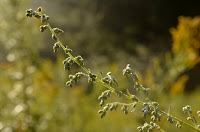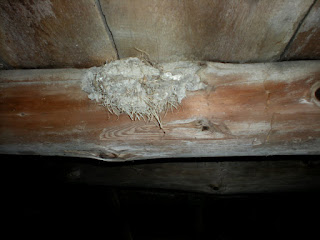What: Just before leaving for Alaska, I was finding great pleasure in taunting the Carolina Locusts (
Dissosteira carolina). It seems like any dry lot or gravely path has at least a couple of these every 10 feet or so that will just explode off the ground when you get close enough. While at rest they virtually disappear into the background - unless that background is a blue tarp - but when they fly, their black wings with yellow border stand out (in flight they superficially resemble mourning cloaks).
Ecological notes: Grasshoppers (Order Orthoptera) undergo incomplete metamorphosis (
hemimetabolism). So rather than have four distinct life stages (egg, larva - like a caterpillar, pupa/chrysalis/cocoon, adult) as with animals that undergo complete metamorphosis (
holometabolism), they have three stages (egg, nymph, adult). Note the different terminology - larva is for animals with complete metamorphosis, nymph for animals with incomplete metamorphosis.
Having distinct life stages allows for a species to partition up habitat between life stages (e.g. monarch caterpillars eat foliage, adults eat nectar) rather than compete for resources. Because nymphs strongly resemble adults (except having underdeveloped wings and no reproductive organs), they might compete for resources. Dragonflies and many other insects avoid this by having aquatic nymphs and terrestrial adults. We can add a new term here:
naiad, which entomologists use to distinguish when a nymph will occupy a different environment than the adult. Grasshoppers and locusts, along with many other insects, don't partition up the environment in this way (called
paurometabolism).
Each shed of the exoskeleton (called an instar) brings the nymph closer to sexual maturity. With Carolina locusts, they get larger and darker. The females will get larger than males (about 2.5" long). Despite the color changes, at each stage they are nearly perfect at blending in to their background. Perhaps the color change from nymph to adulthood forces them to find new backdrops with which to camouflage and avoid competing with other life stages in this way.
Camouflage is a method of concealment of confusion that allows an animal to avoid detection. There are generally three types of camouflage.
Dazzle camouflage totally disrupts a predators judgement about the size, shape, speed, and distance of a prey. Much like this
pinwheel, this pattern is disorienteering. A lion attempting to go after a zebra will have no trouble spotting a herd, but might have trouble picking out one from the pack and visually separating it from the other zebras. Military boats took advantage of this patterning in
World War I and WWII.
An animal may also camouflage itself by pretending to be something that it isn't. I posted earlier about the
beautiful wood nymph moth that conceals itself by mimicking bird poop. Animals that utilize
mimesis take advantage of the fact that predators maintain search images for prey items, avoiding cuing in on things that are inedible, like twigs (e.g. walking sticks, geometrid caterpillars like inchworms), bird poop, thorns (e.g. thorn bugs), leaves (e.g. katydids), etc.
Mimicry is similar, but here only a body part resembles something else rather than the whole body, like those big glowing "eyes" on the wings of a sphinx moth.
Animals may also use a disruptive camouflage technique, called
crypsis, that makes an animal difficult to see. An animal can do this by having a coloration similar to the background, as with the Carolina locust, breaking up its outline, countershading (fish have dark backs, light bellies), or one of the coolest, changing colors, like our native gray treefrog (or is it green?).
The locusts are so good at this. I had not trouble spotting them while they were in the air, but as soon as they landed the game began: trying to spot them in the woodchips, sandy patch, or shadows of grass that they landed in.
Where: Backyards everywhere
Other notes: While locusts, these aren't the species associated with plagues and/or catastrophic agricultural decimation. While common and widespread, they might only seem more abundant because we come into contact with them more often. They prefer dry, rocky/sandy waste places - where better to find this than a city!

.JPG)
.JPG)
.JPG)
.JPG)
.JPG)
.JPG)

.JPG)
.JPG)

.JPG)



.JPG)
.JPG)
.JPG)
.JPG)
.JPG)
.JPG)

.JPG)










.JPG)

.JPG)





